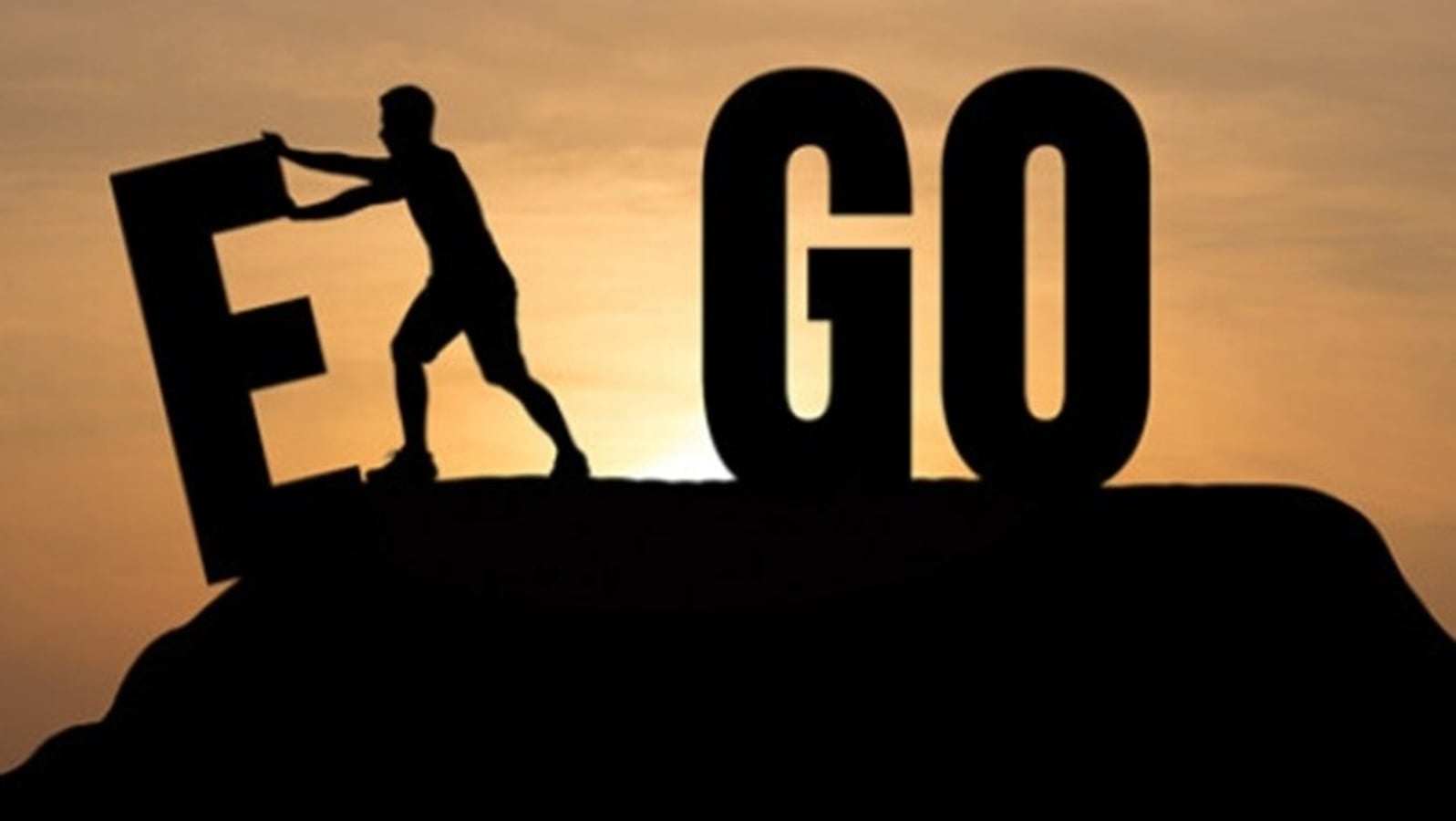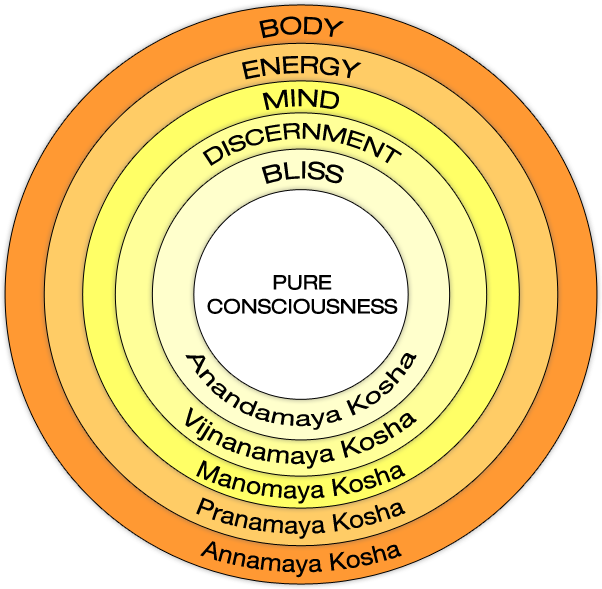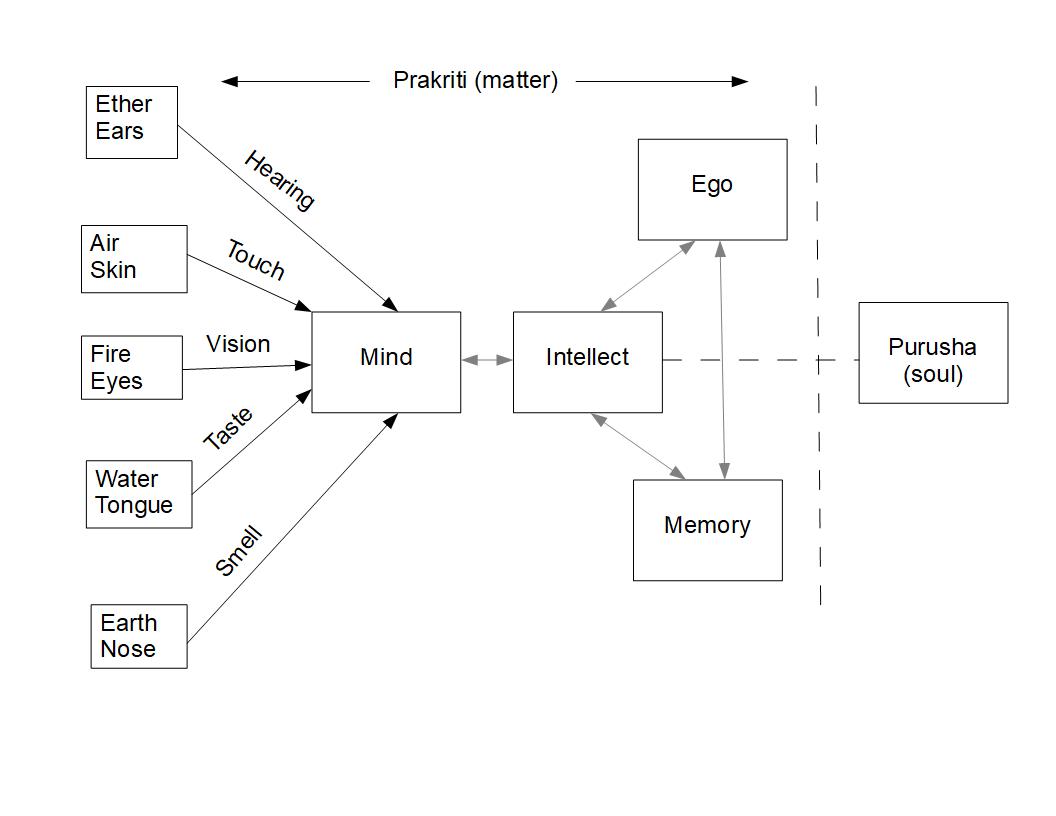If you have attended any of the yoga classes that I teach, you’d have noticed that at the end of the asana sequence and just before yoga nidra, we sit quietly for a “moment of reflection”. During this brief period, we try to replay in the mind the sequence practiced so far like a video replay. This reflection gives us an opportunity to become more aware of ourselves at the physical, breath and mental levels. This enhanced level of awareness helps us identify if at any time the mind, driven by the ego, rather than the intellect, tried to push the body beyond its natural limits
These three levels of awareness represent the lower three of what are known as Pancha Kosha (five levels of awareness). Let’s take a brief look at these levels of awareness.
The five levels of awareness
In the ancient text, the Taittiriya Upanishad (defined in section Brahmananda Valli with further elaboration in the section Bhriguvalli), it states that we can think of our being as a composite of five layers, sheaths or enclosures, called “koshas”. These are:
- Annamaya Kosha (the physical sheath): this sheath is sustained by food. The word “anna” means food and “maya” means composed of or full of.
- Pranaymaya Kosha (the energy layer): sustained by prana or vital life force, represented by our breath at a gross level.
- Manomaya Kosha (the mental layer): primarily the cognitive mind, ego, memory and the lower intellect.
- Vijnanamaya Kosha (the layer of intuitive wisdom – “vijnana”): the higher intellect which is free of influence by the ego.
- Anandamaya Kosha (the layer of “ananda” or bliss): Unconditional, unalloyed source of inner joy or bliss.
Our yoga practice can be used as an effective means of building this awareness. The three key components of a regular yoga practice are – asana (physical posture), pranayama (breathing techniques) and meditation (calming the mind). Through the practice of asana, we develop awareness at the physical level (annamaya kosha), pranayama helps develop awareness at the vital energy level (pranamaya kosha) and meditation can lead to awareness at the last three levels – manomaya kosha, vijnanamaya kosha and anandamaya kosha. Once you deepen your awareness during your yoga practice, you can carry that same level of awareness to your day-to-day life. You can read more details about the five koshas on my blog here.
In our practice, during the “moment of reflection” mentioned above, we try to understand the constant interaction that goes on between the body, breath and the mind. For a given asana, the mind sets the intention and then guides the body through the moves needed for the asana. As an example, let’s take Pashchimottanasana (seated forward bending pose) and see how the mind and body may interact. Here are the basic instructions for the pose:
- Sit down with your legs stretched out in front, feet together.
- When you inhale, put the chin away toward the feet to keep the spine lengthened.
- When you exhale, try to drop the chest closer to the thighs. If your hands don’t reach the toes, use a strap to maintain better awareness of the spine and to help deepen your stretch.
Let’s look at step 3 above. The mind sets the intention to try to deepen the stretch on each exhalation. When mind and body are working together harmoniously, the mind pays full attention to any messages or signals received from the body. If at any time the body becomes uncomfortable, the mind takes a step back and relaxes the pose.
On the other hand, let’s say the mind is being dominated by the ego. You look around and notice that the person next to you is able to touch the toes very comfortably. The ego might say, “if this guy can touch the toes, I MUST try to get there as well.” At that point the ego directs the mind to push the body beyond its limits to try and touch the toes. This obviously can lead to injury in situations where the body is not fully warmed up or just doesn’t have the necessary flexibility to go through the pose. In some cases, the opposite may also be true. The ego might say, “Ah! I am too lazy and don’t feel like trying to stretch. I’ll do some exercise later in the day by taking a walk.” As you can see, both these situations where the ego is playing a role are highly undesirable.
Four functions of the mind
To understand how the mind operates, it is usually described as a composite of four functions given below. In classical yoga literature, the collective term for these four functions is “antahkarana” (inner instrument).
- Cognitive mind (manas – मनस्): this is the cognitive aspect of the mind; it carries out perception and cognition through the five senses as well as activate motor control. It interacts with the intellect and the outside world through the five senses.
- Intellect (buddhi – बुद्धि): This is the decision-making element in the mind-field. It discriminates between all the dualities – good/bad, hot/cold, honor/dishonor etc. and helps us make ‘intelligent’ decisions. It interacts with the ego (ahamkara) and the chitta (storehouse of memories and past impressions, called samskaras).
- Ego (ahamkara – अहंकार): Ego or ahamkara, literally the I-maker, is the one that identifies the Self with the mind-body complex and gives me the notion of my individuality. It interacts with the chitta (memory) and the intellect.
- Storehouse of memories and past impressions (chitta – चित्त): This is where all the memories, past impressions (called samskaras), hidden desires (called vasanas) etc. are stored. Every action that we do, every thought that occurs in the mind, creates an impression which gets stored in the chitta.
You can visit my blog here to read the full article.
Who is guiding my mind – ego or intellect?
The clear message here is that we need to learn how to identify whether our actions are being driven by the ego or the pure intellect. When our yoga practice is guided by the intellect rather than the ego, we make the practice safe, enjoyable, and optimally beneficial.
Having learned the message on the yoga mat, we need to apply the same concept in our day-to-day life. As we know, in many situations in life, we, knowingly or unknowingly, allow the ego to play a dominant role. Almost always it results in some kind of pain or suffering.
One of the challenges that we face in our day-to-day life is how to identify the role of the ego vs. that of the intellect. There are situations when I might believe that my present action is driven by my intellect but, in fact, that may not be the case. I may lack the discriminative wisdom to distinguish between the two.
I am giving below a few sample situations in our day-to-day life that may help us identify the role played by the ego.
“What’s in it for me?”
While working on a project at work, you are solely focused on getting a promotion, salary raise or more recognition by the seniors. What you don’t realize is that this misguided focus is, in reality, a big deterrent in achieving the goals that you are seeking. You are unable to concentrate on the job and end up doing a poor job thus jeopardizing your chances of promotion etc.
On the other hand, if you are driven by your pure intelligence, you’ll be focused on bringing the best outcome for the project. You will invest time in training, learning through research or guidance from seniors so you have the skill set to do your best. This will automatically enhance your chances of getting a promotion etc.
“You make me so proud of you”
This is what parents commonly say when their child does well in sports, academics, music etc. It may not be obvious, but the statement is heavily driven by the ego. The message the child gets is, “I must do what my parent like, so they are proud of me.” Parents are simply interested in getting their ego satisfied. The child is deprived of an opportunity to understand what is best for them. It limits their personality development. It may even make them fearful of their parents and stunt their self-confidence.
Difference of opinion
Let’s say you’re in a conversation with someone and they share a different opinion than yours. When the ego is dominant, you begin to defend your point of view vehemently, even if it’s not based on logic or evidence. Rather than engaging in constructive dialogue, the ego can lead to stubbornness and a desire to “win” the argument at all costs. Your ego is telling you that you’re right and that they’re wrong.
When the intellect is guiding you, you listen to their perspective and try to understand where they’re coming from. You may still disagree with them, but you’re able to have a respectful and productive conversation.
Pleasurable vs. desirable
Here is an example that I always give in the yoga workshops that I offer. When driven by the ego, you will go for the piece of cake which is highly pleasurable, even though you may be severely diabetic or have highly dangerous levels of cholesterol. Of course, when driven by the intellect, you’ll do the desirable which is to avoid the cake altogether. Please read my blog post here for a detailed discussion on this topic.
Yoga (and other physical activities) related injuries
It is common in yoga practice (or any other sporting activity) that driven by the ego, you can push yourself beyond your body’s natural capabilities. You may be driven by a sense of competition and strive to outperform others or even yourself. This can cause serious injury and result in physical and/or mental anguish.
As mentioned above, in the yoga classes that I teach, I always have a brief “moment of reflection” wherein we try to develop a deep sense of awareness about the body and the mind so we can prevent any intervention by the ego in our practice.
Validation through social media
With the ubiquity and popularity of social media, people seek validation and approval on social media platforms, often posting carefully curated pictures and content to boost their ego. In the yoga community, it is quite common to see people posting pictures of their best yoga poses. They go to different locales like the beach, mountain, rocks etc. to shoot pictures so they are more appealing. Then likes, comments, and shares on these media platforms can become measures of self-worth, sometimes overshadowing the rational evaluation of the value of such online interactions.
Status Symbols
Some people are driven by the need to display status symbols like luxury cars and homes, designer clothing, or prestigious job titles to boost their ego and gain recognition. Many times, this involves undermining the financial or personal consequences. Pursuing a career or life path solely for the sake of achieving fame, wealth, or power, without considering personal values or fulfillment, can be driven by the ego’s desire for external validation.
Six enemies of the mind (shad-ripu)
We all know that suffering is an integral part of life. What is the root cause of this suffering? Patanjali, in the yoga sutras, attributes this suffering to avidya (ignorance). When we are ignorant of our true nature, ego takes over and begins to dominate our decision making. As we know, the ego likes to identify every life experience with labels such as “like it/dislike it”, “love it/hate it”, etc. This kind of labeling leads to strong attachments or strong aversions (raga/dvesha) which give birth to the six enemies of the mind discussed below.
It is these strong attachments and aversions, which corrupt our mind with these six negative tendencies, which are commonly referred to as the six enemies of the mind (shad-ripu). All our behaviors and actions are constantly influenced by these six negative tendencies:
- Kama (lust/craving)
- Krodha (anger)
- Lobha (greed)
- Moha (delusion)
- Mada (arrogance, vanity)
- Matsarya (jealousy)
Please read my blog article here for a detailed discussion of these six negative tendencies.
How to let go of the ego
As mentioned above, dominance by the ego results in suffering. Patanjali, in the Yoga Sutras, tells us that by practicing the eight limbs of yoga (called Ashtanga Yoga) one can eliminate all the impurities of the mind (caused by the ego). This helps diminish the influence of the ego and can eventually lead to understanding our true identity – self-realization. The eight limbs of yoga are:
- yama (restraint, interaction with others)
- niyama (observance, applied to self)
- āsana (physical seated posture)
- prāṇāyāma (regulation of breath)
- pratyāhāra (Sense withdrawal)
- dhāraṇā (focus/concentration)
- dhyāna (meditation)
- samādhi (total absorption)
Of these, the three that are important from the point of view of yoga practice are asana, pranayama and meditation. Of these three, the most important practice is that of meditation. Meditation helps us calm the mind so we can think more clearly and use the intellect rather than the ego for our decision-making. We also need a deep understanding of the concepts presented by Patanjali, so we can realize the damage that an elevated ego can cause. With this understanding at an intellectual level, augmented by a regular practice of meditation, we can truly begin to enjoy life and not be bothered by little ups and downs that we are always confronted with. Please visit my blog here for a brief introduction to the yoga sutras and the eight limbs of yoga.
When the intellect gets sharper and influence of the ego is diminished, you will be able to:
- Be open-minded and willing to learn new things.
- Be objective and try to see things from a neutral perspective.
- Be discerning and weigh different options carefully before making a decision.
- Be empathetic and try to understand the feelings of others.
- Be courageous and stand up for what you believe in, even if it’s unpopular.
- Make better decisions in all areas of your life and make choices that are in your best interests.
Recommended daily mental activity
Everyday, at the end of the day, before going to bed, mentally go through the events of the day and pick three of the most significant events. For these events, try to make an assessment as to which of the two – ego or intellect – played a dominant role. When you do this regularly, your assessment will become clearer, and you will become more aware of how not to be influenced by the ego. This will lead to a more peaceful and joyful life.



Great article, lot of helpful content is nicely packaged in this blog. Very well explained and the “four functions of the mind” visual is quite compelling. The point on social media validation is relevant to the times. Nicely concludes with a recommendation that one can take away and easily practice every day.
Thanks for sharing
Thanks, Arvind, for the kind feedback. Glad you found the article helpful.